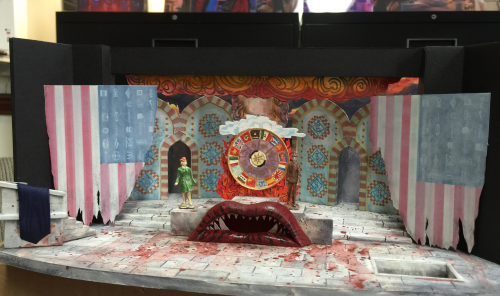
Mary Griswold’s set model for Hydrogen Jukebox
By John Fatuzzo
As Eastman students, when we attend opera performances we are attracted to the characters singing on stage and the accompanying music from the pit. Overlooked sometimes are the aesthetic aspects of the performance, including the set design. The upcoming Eastman Opera Theatre production, Hydrogen Jukebox by Philip Glass, has an enticing set design: a “new age” church that worships the corporate, military and industrial machine of modern America.
I was able to speak with Mary Griswold, the scenic designer for Hydrogen Jukebox. Griswold has over forty Eastman Opera Theatre productions to her credit since 1995. She gave us insight to the world of scenic design and was able to preview some of her work on the set for this evening’s premiere of Hydrogen Jukebox in Eastman’s Kilbourn Hall.
John: For those who may not know much about theatre set design … could you briefly walk us through the process of designing a set from your initial concept meetings with the producer to opening night?
Mary: Stage design is a collaborative process. The producer, who controls the budget, and the director, are generally the ones to have the big ideas, i.e.: Why are we doing this show?
I read the libretto thoroughly to see about any plot requirements that need to be considered, i.e. doors, windows, closets to hide in, etc. As scenic designer, I start by figuring out the ground plan. Once the plan is agreed upon, I develop elevation views. At some point, the director and the other designers will have agreed upon a time period or style and a color palette and I will do research as needed. I particularly like to work with directors who have a knowledge of art history and can suggest a particular painter’s work as inspiration. Next I make a scale model, do paint elevations, and make drawings for the shop to estimate costs and build the sets. At Eastman I am also the scenic artist so I will begin painting as soon as there is some scenery to paint.
John: What are some of the unique and challenging aspects of set design, in general, that theater audiences may not know about?
Mary: Each new production creates a unique world for that show to live in.
John: The action for Hydrogen Jukebox takes place in a “new age church.” Could you tell us about how you and Prof. Daigle [Eastman Opera Theatre director Steven Daigle] interpreted this for the set design?
Mary: It is our production that takes place in an alternative sacred space, a space which incorporates symbols of many aspects of modern life, but one in which the worshipers decide that maybe they don’t believe all that stuff anymore. This is what we came up with after trying out a number of ideas suggested by the poetry, such as a train station or airport because there is so much traveling in the poems.
John: What are some of the particular challenges in designing the set for Hydrogen Jukebox?
Mary: There is nothing in the libretto to suggest anything about how to stage the piece, who the characters are, where we are in time or space. The challenge of the piece is to figure all of this out in some way. That’s also why it was so much fun.